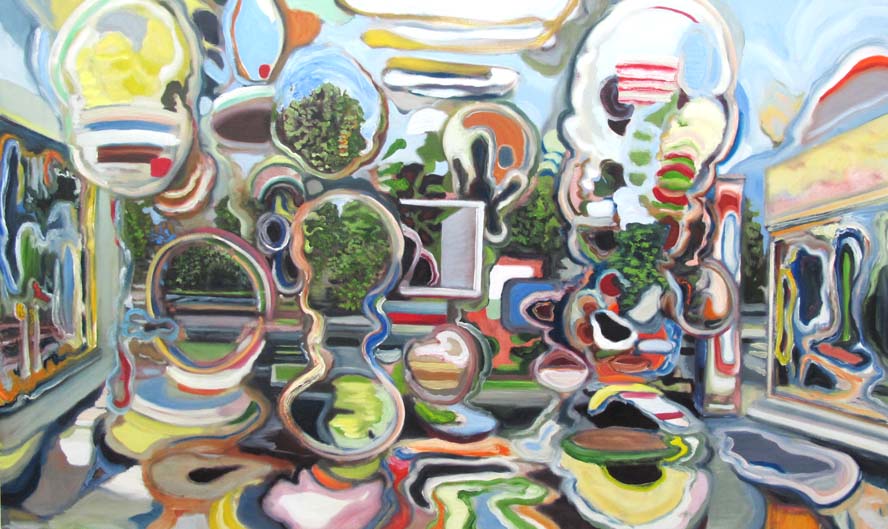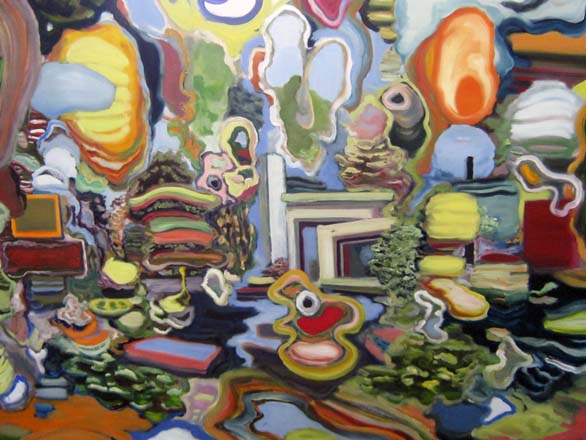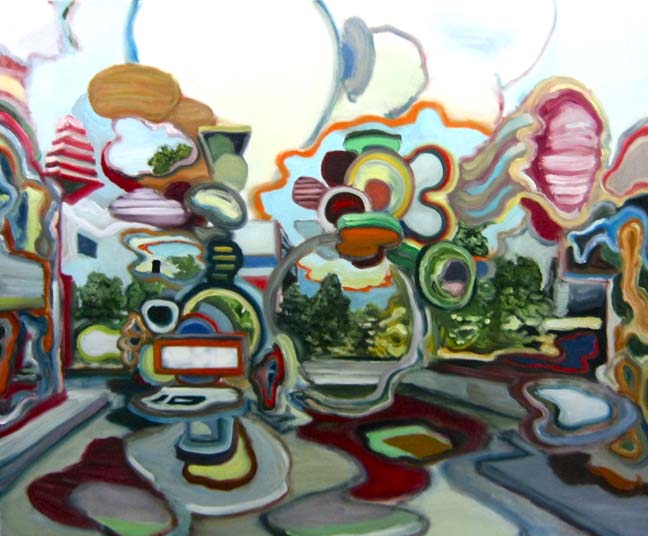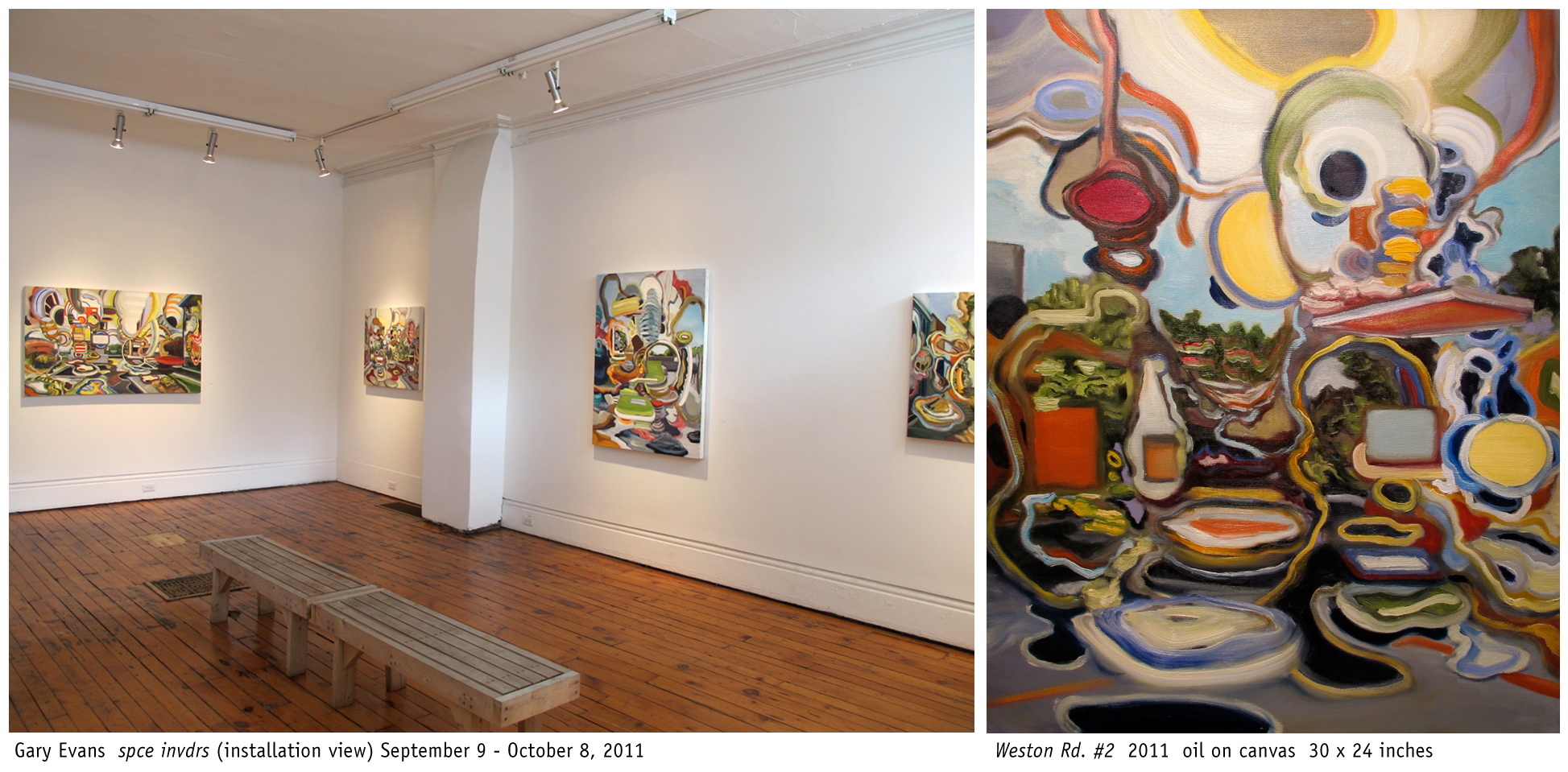spce invdrs
Gary Evans
September 9 - October 8, 2011

On the occasion of our gallery's tenth anniversary at our current location (eighteen years in all) we are pleased to present an exhibition of new paintings by longtime gallery artist Gary Evans. In part to honour this milestone we are also organizing a concise fifteen-year survey of his works on paper. Texts by Rosemary Heather and Nell Tenhaaf accompany the exhibition.
Gary Evans spce invdrs
Rosemary Heather
Writing about the paintings of Jan van Eyck, art historian Erwin Panofsky once said: “Jan van Eyck’s eye operates as a microscope and as a telescope at the same time…compelling the beholder to oscillate between positions very far from the picture and many positions close to it.” The quote could also describe the paintings of Gary Evans — but with the important distinction that, in Evans’ work, the oscillations are inscribed onto the canvas. Rendering dimension in a picture as shifting planes of paint has always been a predominant feature of Evans’ art. It’s a technique that creates oscillations, or suggested shifts in position for the viewer that, in their way, are just as characteristic of the world the artist inhabits as van Eyck’s more detailed figurative paintings were of his.
Panofsky’s quote points to the broad context Evan’s paintings have always had as their first point of reference: the tradition of landscape painting. For Evans, the Dutch painters of the 17th century have particular significance. Van Eyck provides a reference point as a Nordic master who worked in what is considered to be a naturalistic style – which is to say a style unencumbered by the idealizations of Italian Renaissance Humanism. Of greater relevance is Jacob van Ruisdael, whom Evans cites as an influence. Indeed when looking closely at the artist’s paintings, viewers can often glimpse segments of landscape peaking through, styled in a descriptive mode that is distinctively Flemish.
As with all of Evans’ work, in this new series discreet points of interest vie across the flat plane of the picture for the attention of the viewer. Working within the landscape genre, Evans creates a space invaded by competing vistas of visual possibility: alternating coloured planes, small pictorial realms nestled within thickly inscribed circles or simply solid discs of colour or smudges of paint. Evans has long worked with an all-over compositional style. Pulling against this is the artist’s inclusion of definite structure in each work through the use of the receding sightlines of perspectival space. Typically, contrasting swaths of paint appear to billow out from the surface of the canvas; in Evans’ hands, pictorial disarray is animated to resolve into persuasive coherence.
In almost every instance, Evans makes paintings that retain the essential components of the landscape tradition. For all of their (denoted) chaos, Evans’ works always emanate up from a stable ground, not unlike the one you and I enjoy standing on when we get to our feet. Rising up from that ground are paintings that luxuriate inside a definite dimensional space. For this part of Evans’ practice, the Dutch landscape masters provide a useful point of reference. In the era of van Ruisdael, Dutch painting adopted what was considered a more realistic style. Painters began to depict actual spaces in contrast to practice of painting so-called “universal scenes” that are in essence, amalgams. This genre of Dutch painting tends to feature a low horizon, enabling the artist to depict the massive cloud formations that are characteristic of the Dutch landscape. The figure of clouds provides a likely provenance for the forms Evans’ populates his works with, billowing and chimerical – if somewhat denatured and alien to their Dutch antecedents.
This is true even of Evans recent series of spce invdrs paintings, which feature less organic looking, harder-edged amalgams of cascading forms. Seen as a continuum of Evans’ over 16 odd year practice it is as if, under the regime of his paintbrush, the world he creates has a tendency to modulate, expanding or contracting according to his interest. An untitled work from Evans’ current exhibition, for instance, benefits from the context of Evans’ output as a whole to present, apparently, a micro view from the inside of the artist’s world. Micro is the apt metaphor, as the painting suggests the purview of expanded molecules of paint or an increased porosity of Evans’ painterly substance.
Shuttle forward to 2011 and the world Evans’ creates would appear to be contracting; either that or it is getting more crowded, suggesting the artist and the focus of his work have undergone a change of location. The crowding of forms in these new pictures seems to derive logically from Evans’ use of a less blended application of paint. His painted forms are now layered and brightly coloured; combined with a prevalent use of the colour white, the suggestion is of the back-lit brightness of commercial signage. An absence of shading or mixing of colours, means Evans’ paint more or less sits on the surface of the canvas; across the spce invdrs series, an ambience of the inorganic prevails. Evans confirms that the world he is depicting in these new paintings is urban; specifically, that of the big box agglomerations as they might be experienced from a passing car.
Evans calls these spaces: “strangely neutral and oppressive at the same time.” Rendered according to the well-established dictates of Evans’ practice, however, the overall effect is to salvage the aesthetic dimension that is innate to this environment; the paintings are a form of reportage, rather than critique. With spce invdrs, Evans blends not paint so much as spaces, which in his hands appear to coexist and yet meld together. His paintings’ evoke an environment that is not entirely material because of the way it is experienced as mediated by signs and constant message transmission. Hardly exotic or exceptional, it’s the world that we all happen live in. Like van Eyck, Evans renders a kind of realism for his day.
Rosemary Heather
9 September 2011
And to wind back the clock here is a text by Nell Tenhaaf from 1997 that continues to be relevant to Evans' work to this day:
While attending a conference of semiotics at the University of Toronto in Fall 1997, Nell Tenhaaf saw an exhibition of Paintings by Gary Evans at Justina M. Barnicke Gallery at Hart House and was inspired to write this text. Tenhaaf is an electronic media artist, writer and Full-Time Professor in the Visual Arts Department at York University in Toronto.
Gary Evans, Field Work
My first impulse on seeing this work is to resist words. The paintings are so retinal, and so beautiful. They leave an imprint on the eye and mind that I want to keep deliberately pre-rational.
But because I'm immersed in a conference just up the road at Victoria College, Toronto, called “Semiosis, Evolution, Energy,” I decide to filter my perceptual experience through the overdose of theories on signification I'm hearing there. In particular, semiosis of energy seems pertinent to Evans' paintings: what kind of sign system is it possible to form from what I recognise as raw energy, what kind of codification could match that energy?
Semiotic theory says that a resemblance between the sign and its source is first transposed into an iconic representation, a direct image for that source, and that this is the basis of the development of all signification. Meaning is often, but not always, the eventual endpoint. So what is the source here? I think it's certainly not Nature in its mythological capital-N sense. Evans says that he works at roadsides and in fields, so human presence is implicit and it has already acted upon nature. The icon here is derived from mediated nature. That first direct image taken from the source admits that the human eye is in operation, and so I think f this icon as something of an “autonomous perceptual unit,” rather than idea, it's rather like the Impressionists' strategy for painting in the way that it focusses on the light and colour qualities of the source – except that the Impressionists were very attached to the idea of making pictures that mimicked the natural world.
The perceptual units in Evans' works are points of attention, each relates to all the others around it in the paintings, each focal point is a signifying context for the others around it. Unlike the Impressionist idea, there is no attempt to use these units to build a naturalistic scene. Instead, they're in a state of flux, they each “act” autonomously but always in relation, and there's no possible final word on how they inter-relate. So to return to my first impulse, that's how these paintings resist concept, how percept is kept alive and seems to resist language.
The painterly illusion here is not of a view onto Nature, but of an organising principle that is perceptually derived from the natural world but seems finally to be entirely implicit in the process of painting, rather than explicitly arranged or pre-determined.
In the classical semiotic terms of C.S. Peirce, the nineteenth-century American father of semiotics, there is a stage in the generation of an idea which he calls the “fictive simple”: it happens after perception but before naming, so it certainly precedes meaning. The perceptual unit of shape and colour in paint in Evans' work gives me a lucid and explicit set of fictive signs for energy relations in nature. These signs tell me much more about roadside nature than what I could derive from the scenes themselves, they embrace the breath of both the invisible dynamics and the ancient organic origins of what appears as a banal bit of the everyday world. The works permit my view to complete the ultimate semiotic circle, that is to shift between a sense of the actual or physically existent, and the arbitrary space of all possibility.
When Evans says that he thinks of the paintings as “reflections of this wall of matter onto some internal wall...,” he points to the power of visual representation in answering to semiotic perplexities about communication across the great divide that separates organisms. How can I ever know what your internal space looks like, how can you see and interpret what is also in front of my eyes? And conversely, how can you know my subjective experience? Evans' paintings give me, if not an answer to this kind of question, then a sense of reassurance that I can at least glimpse the inside of someone else's inner world. It may be that this can only be articulated in language, but it's my immediate recognition of it that gives these paintings their power.
Nell Tenhaaf, October 18, 1997
-- reprinted from the catalogue Seeing Things: The Paintings of Gary Evans curated by Stuart Reid for the Art Gallery of Mississauga, Kenderdine Art Gallery (Saskatoon), Kitchener-Waterloo Art Gallery, Liane and Danny Taran Gallery at the Saidye Bronfman Centre for the Arts (Montreal), Tom Thomson Art Gallery (Owen Sound) and St Mary's University Art Gallery (Halifax), 2000-2002.







